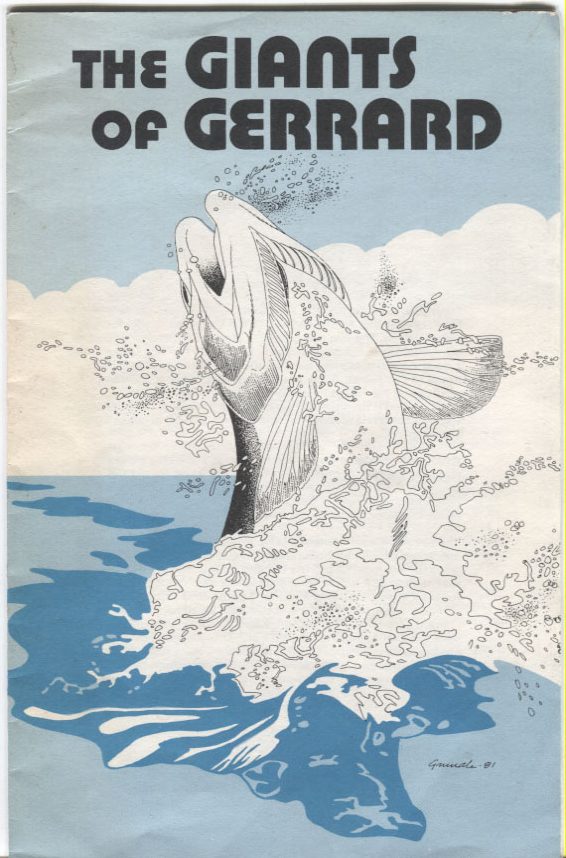The Giants of Gerrard
Under ordinary circumstances, the ghost village of Gerrard might have easily been long forgotten like so many others of its kind including some of its neighbours like Poplar Creek and Gold Hill. But this place is famous, not only in British Columbia but in many other parts of the world because it is here in the first few hundred meters of Lardeau River where it leaves Trout Lake, that the world’s largest form of rainbow trout returns to spawn each spring.
Historical Background
From about 1902 until the Second World War, Gerrard was the terminus of the Kootenay and Arrowhead Line of the Canadian Pacific Railway. Western Canada Timber moved an old mill down from Trout Lake City, refurbished it and built a new mill, camp and town site at Gerrard. My great Uncle Harry Burns was the logging boss. There was even a post office. A steamer ran from Gerrard to Trout Lake City but the line was never extended to Arrowhead. The tracks on this unique railroad which featured truck trains that could be turned by hand at a turntable at Gerrard were pulled in 1942. The rail bed has been used as a road since then. Even in its heyday, Gerrard was a quite village unlike some of the roaring mining camps of the Lardeau District. A fish hatchery
and egg taking station operated off and on from 1912 to 1952 and eggs were shipped around the world
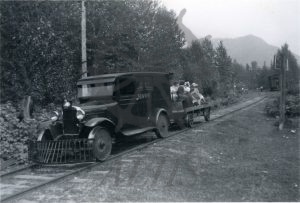
Truck train on the way to Gerrard (Arrow Lakes Historical Society)
When early residents first noticed the big trout, they naturally assumed the fish dropped down from Trout Lake. So did the Dept. of Fisheries and a fence and trapping facilities were built facing upstream. Imagine the fishery officers’ surprise in the spring of 1914 when they saw fish accumulating below the fence
The fish were coming from Kootenay Lake. Realizing their mistake the officers developed an elaborate method to catch the fish. A large seine net was attached to the Gerrard Bridge then thrown into the river to float past a number of fish. It was then quickly drawn in and the spawners were transferred to holding pens to ripen. They were then spawned by hand and released. The eggs were reared at Gerrard or nearby hatcheries at Lardo, Argenta, Kaslo or Nelson. Some were even shipped to more distant hatcheries in BC or the US. After 1939, shipments were increased with the hope of starting populations elsewhere. Success was negligible and, by the 1940’s, The Gerrard run started to decline. By the mid 1950’s, the run had been reduced to 40-50 fish. There were other reasons for the decline, it was more than the generous gifts of eggs and fry to other states and countries Fishing pressure was increasing in Kootenay Lake aided by the Nelson Gyro Derby and the increasing size and comfort of boats and especially the reliability of outboard motors. Kootenay is a large and dangerous lake where violent storms can kick up quickly. It was an anglers’ worst nightmare to be caught out in the middle of Kootenay Lake with a storm on the horizon yanking on the starting rope in of one of those old outboards. The massive Handy Creek log jam was also problematical in hindering the fish from reaching Gerrard. In the early 1950’s the egg station closed, the log jam cleared and the derby discontinued. A nutrification program was also instituted to increase the plankton supply for kokanee and some Gerrard rainbows were reared at Meadow Creek. The returns gradually improved until the peak returns were around 1000 in 2011. Biologists believe that peak spawner counts only represent a half to one third of the actual population size This is fortunate because these fish are a world class resource and one of the regions greatest assets and they spawn nowhere else, A small but unknown number spawned in the Duncan River below Duncan Lake but they were eliminated by Duncan Dam (as were many Bull Trout and kokanee). A few also spawned on a gravel bar near Balfour and may still do.
The Gerrard Spawning Site
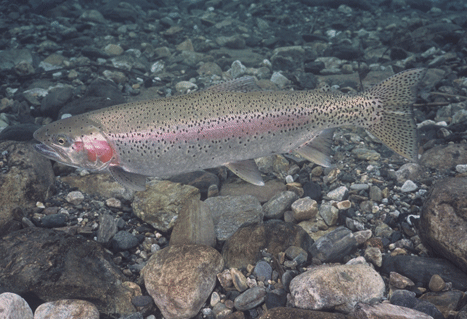
A beautiful female rainbow on the spawning site at Gerrard
Other, smaller forms of Kootenay Lake rainbow spawn in other places, it is almost certain that the large fish spawn nowhere else now. Why? There are many other large creeks with what looks like suitable spawning gravel and many miles of the Lardeau River below Gerrard. Why don’t some of the fish spawn there?
The eggs of trout and salmon require a clean and relatively stable gravel environment for optimal survival. Trout Lake acts as a huge settling basin for mountain creek sediment and stabilizes flow. As a result, much of the 400m section of the Lardeau between the lake and Mobbs Creek, the first unstable and sediment laden tributary, is ideal spawning habitat. The gravel is very clean, flow fluctuation is minimal and temperature is a little warmer and more conducive to egg development. Water is drawn from a large warming surface instead of melting from snow and glaciers most other Kootenay Lake tributaries and the Lardeau below Mobbs Creek become galloping torrents of cold and dirty melt water during the rainbow egg incubation period. Any eggs deposited in these places would be crushed or washed away Kokanee, Bull Trout and whitefish spawn in many of these non-buffered streams but they do so in the fall before the creeks run wild. Egg to fry survival at Gerrard is estimated to be at least 50 per cent. This is about five times greater than most other rainbow spawning runs.
Other features of the site that are conducive to the perpetuation of the big rainbows are its large gravel and relatively swift flow. The riverbed is composed of large gravel and small boulders under flows that are heavier than most other rainbow spawning streams. Therefore larger individuals are favoured because they are more able to hold a position and excavate redds in the substrate. It’s a matter of natural selection.
Life History
In spring when most low elevation snow is gone and streamside leaf buds are swelling, big Kootenay Lake rainbows begin to make their way up the Lardeau. The migration begins late in April and is generally over by late May. Most of the fish move by night and reach Gerrard in about 13 days. Peak spawning is early May.
When the trout are ready to spawn, the females selects a site digs a nest (red) with strong flexes of her tail and lower body, When her work is complete, both sexes settle into the red and release eggs and sperm. The female moves upstream to cover the red and the pair move to a nearby location to repeat the process until most of the eggs are deposited. The average female carries about 8000 eggs but not all of them can be released. About 10 per cent are retained and absorbed.
Several thousand whitefish are also hanging around Gerrard in the rainbow spawning period. These opportunists drop down from Trout Lake hoping to pick up a few loose eggs. They get a few but are no threat to the trout. A few suckers also spawn at Gerrard. They are no threat.
After about six weeks in the gravel, the eggs hatch and the fry struggle up to the stream. They hide in the stones of the red for a few days then work their way over to the calmer water of the stream margins and begin feeding on zooplankton that drift down from Trout Lake and larval forms of river insects. After a few weeks of growth in the excellent rearing conditions provided by the warmer, clear water and zooplankton provided by Trout Lake, many rainbow fry move down to Kootenay Lake under the cover of night. Those that survive the perils of 65 km of sometimes raging river make the lake in late summer. Larger portions of the little trout remain in the river until the following spring. They move down more gradually and feed along the way.
When the young rainbows reach Kootenay Lake they are from seven to fifteen centimetres long. They spend most of their first years feeding hard and after two or three years he fish are about 40 cm long begin to attack kokanee and grow rapidly. After a couple of more years, the Gerrard rainbows are trophy fish that weigh as much as 16 kilos their average weight is closer to 8 kilos. The largest Gerrard rainbow ever caught was 23.6 kilograms or 52 pounds. It was taken from Jewel Lake near Greenwood. Its remarkable size resulted from the fact that it was one of a few fish introduced to a lake with lots of forage fish. Kootenay Lake was 35.5 pounds taken in 1975 by George Hill of Grey Creek. Unlike many form of rainbow, the Gerrard are voracious fish eaters. It is because of this habit that they grow much larger than average rainbows. I was once employed by the BC Fish and Wildlife Branch to examine the gut content of big rainbow guts turned into Kaslo Marine Service or Fred Jones. Almost every gut was stuffed with kokanee save the
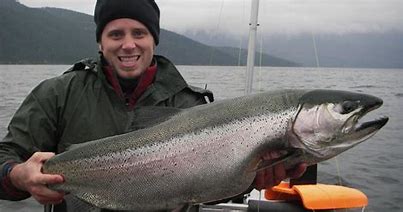
A trophy Kootenay Lake rainbow
very odd one that was full of Carpenter ants.
After 4 -6 years of life in Kootenay Lake, the rainbows begin to mature and feel the pull of their natal stream. In the autumns and winter of their maturity, they lose the bright vitality of youth and take on a more e sombre appearance. Their backs, heads, flanks and fins darken and their bellies have a dishwater coloration. The pink flush on their sides becomes a more vivid red stripe and males jaws become hooked and elongated; they will be heading for Gerrard soon where many will end their lives. Few die immediately after spawning but only 5 to 10 per cent will survive to spawn again. Rainbow trout are aggressive on their spawning grounds. The males battle frequently. Spawning is a stressful event. If the fish survive the rigours of spawning, they still have to contend with 65 kilometres of icy, turbulent and almost foodless water between mobs Creek and Kootenay Lake. The fish that make the lake are quite susceptible to angling –they are very hungry, A few very strong fish are able to cope with all this and some even survive a second spawning. One really remarkable fish lived 14 years and spawned at least three times. An angler found it floundering on the surface near Lardo and brought the skinny, beat up fish into the Fisheries Research Station in Nelson. Normal rainbow trout are fortunate to live much be yond 3 or 4 years. Their long life is another reason Gerrards can attain such large size.
Management
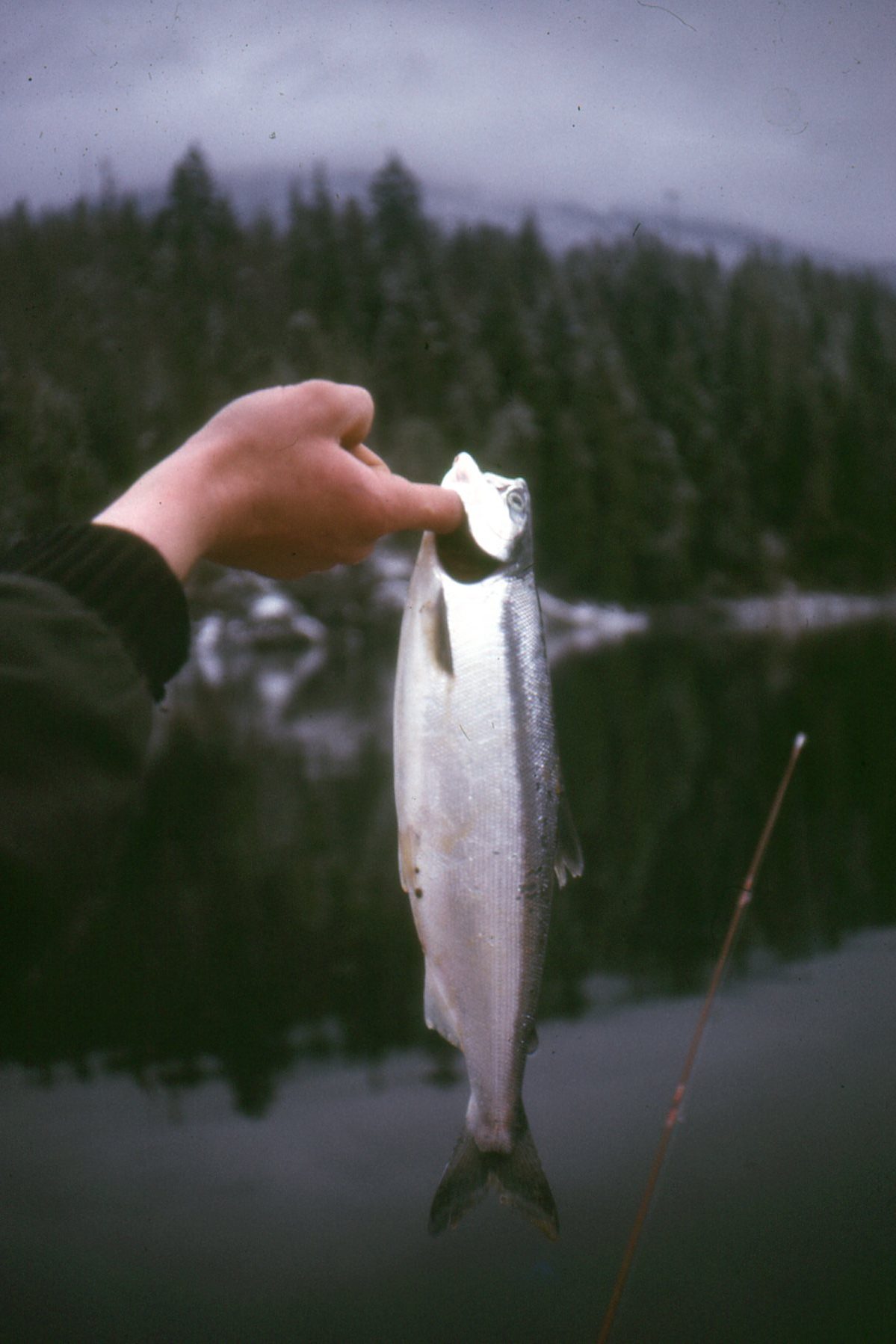
A West Arm kokanee
Stock protection is the foremost priority. Catch regulations have been appropriately conservative and habitat protection has been strong.
There have been problems with logging in the Lardeau Region but as far as I know, it has been controlled. The Forest Service is now a more active player in habitat protection. The Lardeau River and associated lateral waters have been closed for decades to protect adult migrants and young fish. An occasional Bull Trout is poached from the Lardeau but this is becoming rare, the north end of Kootenay Lake has long been closed.
Despite these efforts, Kootenay Lake has been experiencing fisheries and ecological woes. In the 1960’s, eutrophication caused by input of fertilizer from a Cominco (now Teck) Plant in the East Kootenay caused havoc in the West Arm. Then came the opposite: after Libby Reservoir became operational. The reservoir caught the nutrients and processed them in the basin leaving little for Kootenay Lake. There was a kokanee crash due to the nutrient loss and greedy fishermen. Nutrients were added and recovery was well underway but as of 2013, there has been another kokanee decline. Some think the build up of rainbows may have played a role by cropping the silvers too much. The rainbows themselves are said to still be strong just not as large.
Aside from nutrient restoration, a lot of effort has been expended to shore up kokanee. The Meadow Creek spawning channel was constructed to compensate for Duncan Dan cutting off huge numbers. Other spawning channels at Kokanee and Redfish Creeks have been added. Catch has been highly reduced. But Kootenay kokanee numbers remain low and the population has proven quite fragile despite huge numbers at some points.
I am confident that biologists will eventually get it right and attention can be directed to other Kootenay Lake fisheries like the long neglected West Arm
Rainbow fishery which was once far more popular than the Main Lake troll fishery for the Gerrard Giants and Bull Trout. The West Arm rainbows were usually much smaller than the Gerarrd fish but they are right in the lap of Nelson and supported a strong local fishery with occasional big fish and nice average size of some 40 plus cm. With some god fortune and perseverance, all of the spectacular Kootenay Lake fisheries will be restored to their full glory and the Gerrard Giants will continue on as the world’s finest specimen of rainbow trout.
This is an update of a 1981 brochure prepared for the BC Fish and Wildlife Branch by Ted Burns. Art Work by Jack Grundle.
Ted Burns
August 20/2020
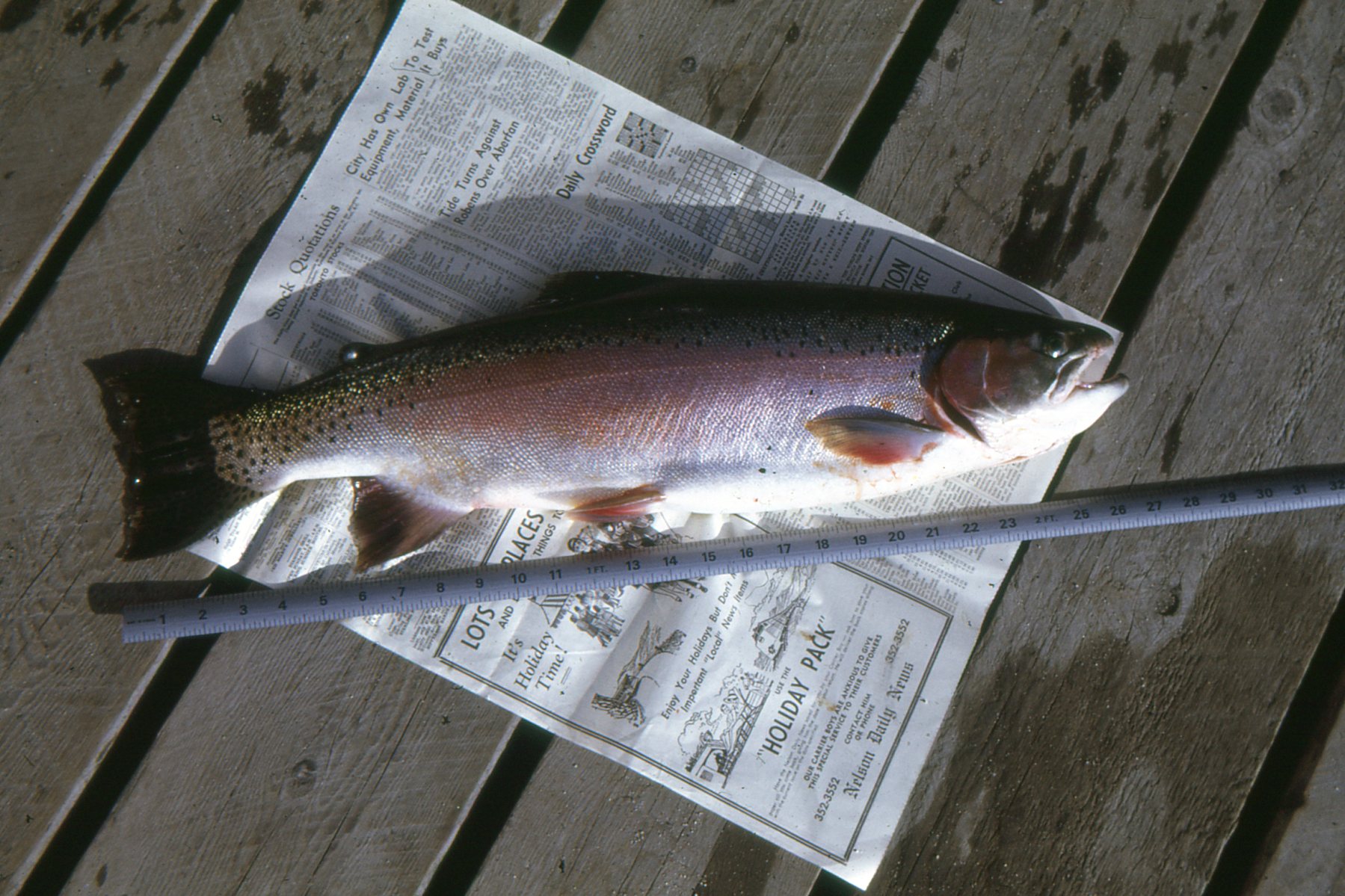
A lovely West Arm rainbow
